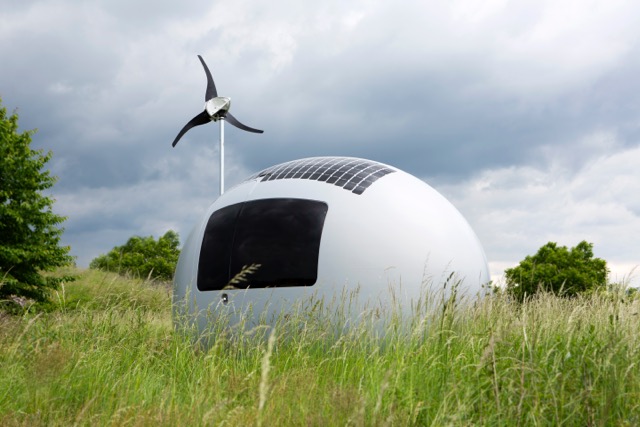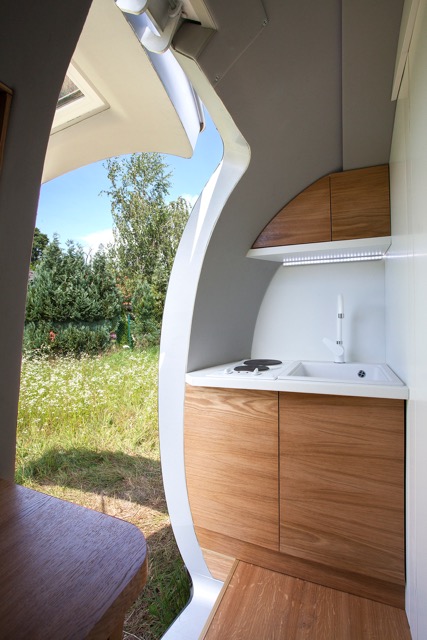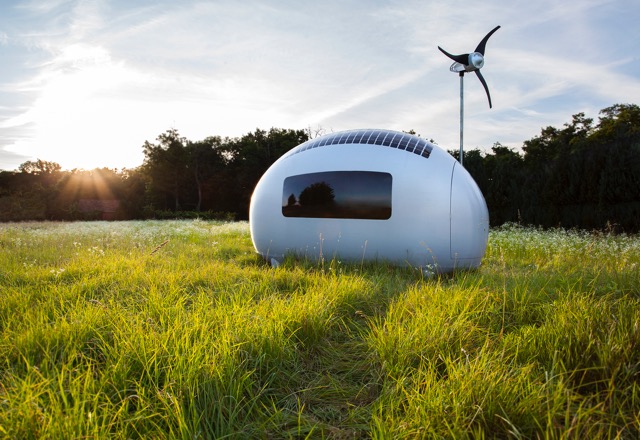
The story of the Ecocapsule began in 2008 when architectural studio NICE Architects participated in the Andes Sprout Society idea competition to design small housing units for artists.
At that time, Ecocapsule v1 had three pivotal design features: A round shape to minimize energy losses, water collection capability and mobility. That particular design was not successful, but a breaking point for the project took place soon after when inhabitat.com chose Ecocapsule as one of the most interesting examples from the Sprout Society competition.
Since then, a flood of inquiries persuaded us (NICE Architects) to develop this project further. Unfortunately, back in 2008, technology was not ready for our concept of a truly independent house.

But by 2014, development allowed us to finish designing the Ecocapsule v2 prototype equipped with necessary systems for long-term independence.
It was designed as a self-contained system, able to operate for long periods of time without external resources. Something like a of Swiss-army knife – it packs everything you need in one place. Long-term independence is mostly a matter of strategy: How to harness and reuse every kind of energy available. A dual power system contains high-efficiency solar cells and silent wind turbines, thus allowing one to bypass periods without sufficient sunlight or wind.
Produced energy is stored in the batteries to power all onboard systems. A thick layer of efficient thermal insulation and energy recuperation significantly reduces thermal losses. The round shape helps to collect rainwater and a series of membrane filters allow filling tanks from any natural water source. Biowaste is collected in the composting toilet.

Then there is the electric incineration unit. Heat from the incineration is used for heating. All these small elements, working together, create a system able to sustain without resources for long periods of time.
Manual water pumps were installed as a backup system. The capsule retains its basic functionality as a shelter. Ecocapsule bears its architectural heritage. It is built as a low-energy house. The key to a successful survival strategy is strict management of energy resources. A conventional house can afford to lose several watt/hours but that’s not the case for Ecocapsule. The difference is crucial. An onboard low consumption computer provides more efficient means of control.
Long-term off-grid stay was always burdened by lack of resources and constant resupply. Usually it means constant flow of equipment and fuel, which negatively impacts the environment. The fact that this capsule is equipped with everything needed limits the impact to the environment just like its footprint.

Initially. Ecocapsule v1 was significantly larger and raised lot of questions about transportation of the unit. Reducing size to something that would fit in shipping containers eased transportation problems. It can be transported by truck, towed on a trailer and in 2016 it will receive its undercarriage.
At first we planned to use the Ecocapsule as a frontier dwelling; as a housing unit for people who need to stay outdoors for a long time. For example: scientists, photographers, rangers or extreme tourists.
Easy mobility, containerization and long-term energy independence opened new ways to utilize the full potential of the capsule. It can be quickly shipped and used as housing for emergency teams in rapid response situations where infrastructure is damaged; after an earthquake, for example. Teams can directly approach their tasks without need to build their base and facilities. The capsule can also serve as a small power plant and water filtration unit.

Interestingly, the capsule can be used as an urban dwelling for singles in the high-rent, high-income areas like New York or Silicone Valley. It can be placed on a rooftop or vacant parking lot and substitute as a studio for a longer period of time. During the construction of the capsule, we learned a most valuable lesson: If you want to survive, you need to utilize all resources you have available. Otherwise you will be punished by limited function.
I guess, that is also applicable to planet Earth. Only the punishment will be more severe.
Submitted by NICE Architects
Web: www.nicearchitects.sk/en